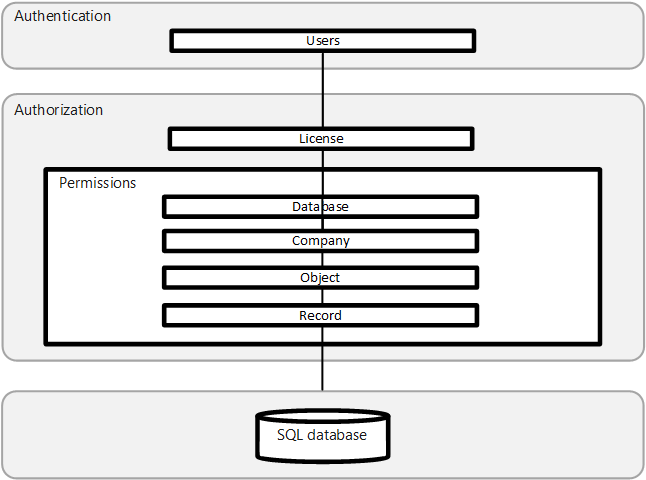Data Security in Business Central
The Business Central security system allows you to control which objects or tables a user can access within each database. You can specify the type of access that each user has to these objects and tables, whether they are able to read, modify, or enter data.
You can specify which records are stored in the tables that each user is allowed to access. This means that permissions can be allocated at both the table level and the record level.
The security system contains information about the permissions that have been granted to each user who can access a particular database.
This information includes the roles that the users have been assigned, as well as any permissions that they have been granted to individual users.
There are four different levels of security:
Database
Company
Object
Record
Graphically, these can be represented as the layers, where the central layer is the records in the database.

When you open a company in Business Central, your ability to access information is determined by the security system.
Object-level security is the set of permissions on Business Central objects that constitute a permission set. Permission sets determine the access that users have and the tasks that users can perform on objects in the database.
You can define permissions for all types of objects in a Business Central database.
| Object Type | Description |
|---|---|
| Table Data | The actual data that is stored in the tables. |
| Table | The tables themselves. |
| Pages | The pages that are used to view and enter data. |
| Report | The reports that are used to present the data. |
| Codeunit | The codeunits that are used in the database. |
| XMLport | The XMLports that are used to import and export data. |
| Query | The object that you use to specify a dataset from the database. |
| System | The system tables in the database that allow the user to make backups, change license files, and so on. |
The various permission sets that exist in Business Central determine the actions that you can perform on these objects. For more information about permissions, see Permissions on Database Objects.
This section provides an overview of permissions and permission sets in Business Central
If you have been granted permission to read a page, then you can open the page and view the data that it displays. If, however, you do not have write permission, you are not allowed to enter data into this page.
Sometimes, when you open a page it displays information from several tables. To access this page, you must have permission to view all the data displayed by the page. You might not have permission to read directly from all the tables that the page uses. In this case, you must have indirect permission to read from the tables in question. Having indirect permission to a table means that you cannot open the table and read from it but can only view the data it contains indirectly through another object, such as a page or report, that you have direct permission to access.
Business Central has a number of standard predefined security permission sets. You can use these permission sets as defined or you can change a permission sets to suit your particular needs. You can also create your own permission sets and assign them the permissions that you want.
| Permission | Description |
|---|---|
| Read | You can read this object. |
| Insert | You can insert data into this object. |
| Modify | You can modify data in this object. |
| Delete | You can delete data from this object. |
| Execute | You can run this object. |
For more information, see Permissions on Database Objects.